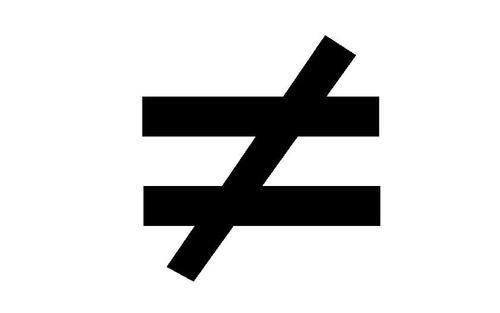

An interesting thing to note here is that the >= & <= operators also check for Equality. If you use the assignment operator to test for equality, then your script fails. Comparison Operators and DateĪs you can see, the comparison operators on date work correctly. For example, you can check whether two objects are equal or not, which can be accomplished with the help of (double equal) sign. Because the equal sign is used for both the numeric equality operator and the string comparison. If the value of two operands are not equal it returns. Since 1 does not equal 2, this evaluation returns 0. For a case insensitive comparison, you need to convert the string either to upper case or lower case. Not equal is an comparison operator which is used to check the value of two operands are equal or not. The symbolic representation of Not equal operator in JavaScript is. If the value of two operands are not equal it returns true. All capital letters are “less than” all lowercase letters. Not equal () Not equal is an comparison operator which is used to check the value of two operands are equal or not. else the operand with longer length is considered greater. In the end, if both operands are finished, then the strings are Equal. And the process continues until it reaches the end. If the characters are equal, then the comparison moves to the next character. If these are greater or less, then the comparison ends and result is returned. This operator tries to compare values irrespective of whether they are of different types. There are six comparison operators available in AMPscript. The result of the evaluation will return a Boolean result. In a character-by-character comparison starts with comparing the first character of both operands. The JavaScript not equal or inequality operator () checks whether two values are not equal and returns a boolean value. Comparison Operators Comparison operators are used to compare two values, or operands. And the comparison is done character-by-character basis, using the Unicode values of the characters. The strings comparison uses the dictionary or lexicographical order.

Because date is object and to be considered equal, they must point to the same object.Ĭomparison involving any other types will always result in false. I have highlighted the CPU(s) column.įor some processes, the CPU(s) column is blank (null, empty).Note that using Equality Operators = & = does not work on dates. Code: Sub NotEqualExample2 () Dim k As Integer End Sub. The command returns all processes running on your local computer. Now, our requirement is if Value 1 is not equal to Value 2, then we need the result as Different, or else we need the result as Same. This is the exact opposite functionality of the equals sign (), which will output TRUE if the values on either side of it are equal and FALSE if they are not. The steps to use the IF function and the not equal to operator are listed as follows: Step 1: Enter the following formula in cell C2.
Open a PowerShell prompt and run the command below: Get-Process You can also use <> for Not Equal To (), > for Greater Than or Equal To (), and < for Less Than or Equal To (). If they are not equal, it will output TRUE, and if they are equal, it will output FALSE. Use the IF function and the not equal to operator of Excel.
The syntax to use Not-Equal Operator with operands is operand1 operand2. Moreover, you can also use the PowerShell “Not Equal” operator test for an empty value in PowerShell with “” (2 double-quotes without anything within the quotes). The symbol used for Not-Equal Operator is. To test for the null value, use the $null automatic variable. You can use the “ne” to test if a value is null. In PowerShell scripting, there are so many reasons you may want to test for null or empty values.
DOES NOT EQUAL SIGN SCRIPT HOW TO
How To Use PowerShell Not Equal Operator To Test Null or Empty Values The difference between this last command and the first one is that “c” is added after the “-“. However, if you want to make it case sensitive, use the syntax below: "item 1" -cne "item 2" Unlike the second syntax with the “ or” operator, the third syntax – with the “and” operator – will only return True if the “Not Equal” comparisons on both sides of the “ and” operator are True.įinally, the “ne” operator is not case sensitive (it is case-insensitive). Moreover, in the second syntax, the command will return True if either of the “Not Equal” comparisons on both sides of the “ Or” operator is True. The first syntax of the PowerShell Not Equal operator retunes True if item 1 is NOT equal to item 2.


 0 kommentar(er)
0 kommentar(er)
